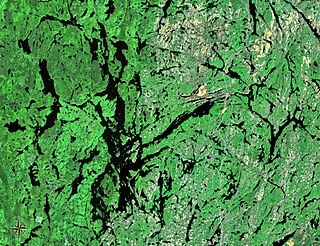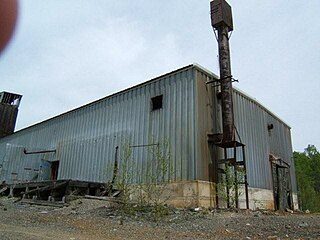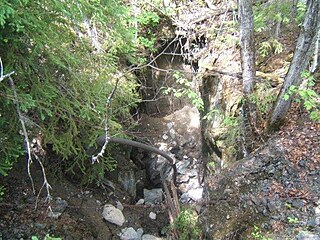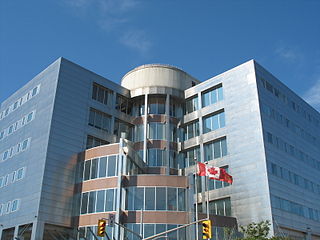
Lake Temagami, formerly spelled as Lake Timagami, is a lake in Nipissing District in northeastern Ontario, Canada, situated approximately 80 km north of North Bay. The lake's name comes from Te-mee-ay-gaming, which means "deep water by the shore" in the Ojibwa language.

Temagami, formerly spelled as Timagami, is a municipality in northeastern Ontario, Canada, in the Nipissing District with Lake Temagami at its heart.

Copperfields Mine, originally known as Temagami Mine, is an abandoned copper and silver mine on Temagami Island in Lake Temagami, Ontario, Canada. The mine opened in 1955 and comprises both underground and surface workings within a sulfide ore body. Situated in Phyllis Township, the mine produced 34,000,000 dollars Canadian with 80 million pounds of copper, 230,028 ounces of silver and 13,271 ounces of gold. It was considered to be the largest deposit of nearly pure chalcopyrite ever discovered in Canada. A mill was not initially needed because the ore was 28% copper. The mine closed in 1972 and is now flooded by water. Ruins of the Copperfields mill are present as foundations. It is possible to find mineral specimens in the spoil heaps of the old mine, such as chalcopyrite, pyrite, bornite, malachite, dolomite, hessite, merenskyite, millerite, palladium, quartz and others. The Lake Temagami Access Road was created to ship ore from the mine site.

The Kanichee Mine, also less commonly known as the Ajax Mine, is an abandoned base metal and precious metal mine, located in the Temagami region of northeastern Ontario, Canada. It is near the small unincorporated community of Temagami North, accessed by the Kanichee Mine Road from Highway 11. The Kanichee Mine zone has been explored and mined discontinuously from as early as 1910. During the 20th century, it operated and closed down at least three times, with the most recent being from 1973 to 1976. To date, the discontinuous operation of Kanichee Mine has produced 4.2 million pounds of metal.

The Temagami Greenstone Belt (TGB) is a small 2.7 billion year old greenstone belt in the Temagami region of Northeastern Ontario, Canada. It represents a feature of the Superior craton, an ancient and stable part of the Earth's lithosphere that forms the core of the North American continent and Canadian Shield. The belt is composed of metamorphosed volcanic rocks that range in composition from basalt to rhyolite. These form the east-northeast trend of the belt and are overlain by metamorphosed sedimentary rocks. They were created during several volcanic episodes involving a variety of eruptive styles ranging from passive lava eruptions to viscous explosive eruptions.

Beanland Mine, also known as Clenor Mine, is an abandoned surface and underground mine in Northeastern Ontario, Canada. It is located about 1 km (0.62 mi) west of Arsenic Lake and 4 km (2.5 mi) northwest of the town of Temagami in central Strathy Township. It is named after Sydney Beanland, who first claimed the mine site in the 1920s and was a director for the mine from 1937 to 1938.

James Lake is a lake in northeastern Ontario, Canada, located in the Temagami region along Highway 11.

Barton Mine, also known as Net Lake Mine, is an abandoned surface and underground mine in Northeastern Ontario, Canada. It is located about 0.50 km (0.31 mi) north of the Temagami Arena in Temagami North and just east of the Ontario Northland Railway in northwestern Strathy Township. Dating back to the early 1900s, it is one of the oldest mines in Temagami. Barton was the site of a fire in the early 1900s, after which it never had active mining again.

Big Dan Mine is an abandoned underground mine in Northeastern Ontario, Canada. It is located about 1 km (0.62 mi) southwest of Net Lake and just west of the Ontario Northland Railway in east-central Strathy Township. It is named after Dan O'Connor, who first claimed the site in the 1890s.

Best Township is a geographic township comprising a portion of the municipality of Temagami in Nipissing District, Northeastern Ontario, Canada. It is used for geographic purposes, such as land surveying and natural resource explorations. Neighbouring geographic townships include Gillies Limited Township to the north, Banting Township to the west, Chambers Township to the southwest, and Strathy and Cassels townships to the south.

Hermiston-McCauley Mine is a large abandoned underground gold mine in Strathy Township of Temagami, Northeastern Ontario, Canada. It is located between the southwestern arm of Net Lake and the south arm of Kanichee Lake.
Mopani Copper Mines PLC ("Mopani") is a Zambian registered company owned by Carlisa Investments Corporation and ZCCM-IH (10%). Minority shareholders are spread throughout the world, in various locations.

Johnny Creek is one of many creeks running through the Temagami region of Northeastern Ontario, Canada. It is located about 4 km (2.5 mi) south of Temagami North in southeastern Strathy Township. The creek is entirely within the municipality of Temagami, flowing in a west–east direction.

Temagami-Lorrain Mine is an abandoned surface and underground mine in Northeastern Ontario, Canada. It is located about 10 km (6.2 mi) northeast of the town of Temagami near Sauvé Lake in central Cassels Township. It is named after the Temagami-Lorrain Mining Company, which carried out work on the property in the early 1900s.

Priest Mine is an abandoned surface and underground mine in Northeastern Ontario, Canada. It is located about 19 km (12 mi) northwest of the hamlet of Marten River on an island in north-central Cross Lake. Dating back to the early 1900s, it is one of the oldest mines in the municipality of Temagami.

The Danlou Occurrence, also known as the Danlou Gold Occurrence and the Mortimer Occurrence, is a mineralized zone in Northeastern Ontario, Canada. It is located 10 km (6.2 mi) north-northeast of the town of Temagami between Highway 11 and the Ontario Northland Railway. It is named after Danlou Mines Limited, which did work on the Danlou Occurrence in the early 1960s.

The Northeast Arm Iron Range, also called the Temagami Iron Range, is an elongated area of iron ore in Nipissing District of Northeastern Ontario, Canada. It parallels the western side of Lake Temagami's Northeast Arm near the village of Temagami at its northern end. One of many small iron ranges in the Temagami area, the Northeast Arm Range consists of alternating bands of iron-rich and iron-poor sediments. It was discovered in the 1890s and has since seen sporadic mining and mineral exploration activities.






















